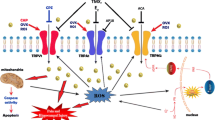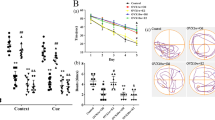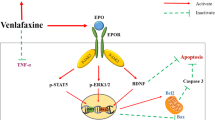Abstract
It is well known that 17β-estradiol (E2) has an antioxidant role on neurological systems in the brain. Raloxifene (RLX) and tamoxifen (TMX) are selective estrogen receptor modulators. An E2 deficiency stimulates mitochondrial functions for promoting apoptosis and increasing reactive oxygen species (ROS) production. However, RLX and TMX may reduce the mitochondrial ROS production via their antioxidant properties in the brain and erythrocytes of ovariectomized (OVX) rats. We aimed to investigate the effects of E2, RLX, and TMX on oxidative stress, apoptosis, and cytokine production in the brain and erythrocytes of OVX rats.
Forty female rats were divided into five groups. The first group was used as a control group. The second group was the OVX group. The third, fourth, and fifth groups were OVX + E2, OVX + TMX, and OVX + RLX groups, respectively. E2, TMX, and RLX were given subcutaneously to the OVX + E2 and OVX + TMX, OVX + RLX groups for 14 days after the ovariectomy respectively.
While brain and erythrocyte lipid peroxidation levels were high in the OVX group, they were low in the OVX + E2, OVX + RLX, and OVX + TMX groups. OVX + E2, OVX + RLX, and OVX + TMX treatments increased the lowered glutathione peroxidase activity in erythrocytes and the brain and reduced glutathione and vitamin E concentrations in the brain. β-carotene and vitamin A concentrations in the brain and TNF-α and interleukin (IL)-1β levels in the plasma of the five groups were not significantly changed by the treatments. However, increased plasma IL-4 levels and Western blot results for brain poly (ADP-ribose) polymerase (PARP) in the OVX groups were decreased by E2, TMX, and RLX treatments, although proapoptotic procaspase 3 and 9 activities were increased by the treatments.
In conclusion, we observed that E2, RLX, and TMX administrations were beneficial on oxidative stress, inflammation, and PARP levels in the serum and brain of OVX rats by modulating antioxidant systems, DNA damage, and cytokine production.





Similar content being viewed by others
Abbreviations
- E2:
-
17β-estradiol
- GSH:
-
Reduced glutathione
- GSH-Px:
-
Glutathione peroxidase
- LP:
-
Lipid peroxidation
- MDA:
-
Malondialdehyde
- PARP:
-
Poly (ADP-ribose) polymerase
- PARP:
-
Poly (ADP-ribose) polymerase
- PUFAs:
-
Polyunsaturated fatty acids
- RLX:
-
Raloxifene
- ROS:
-
Reactive oxygen species
- SERMs:
-
Selective estrogen receptor modulators
- SOD:
-
Superoxide dismutase
- TMX:
-
Tamoxifen
References
Albukhari AA, Gashlan HM, El-Beshbishy HA, Nagy AA, Abdel-Naim AB (2009) Caffeic acid phenethyl ester protects against tamoxifen-induced hepatotoxicity in rats. Food Chem Tox 47:1689–1695
Altmann JB, Yan G, Meeks JF, Abood ME, Brailoiu E, Brailoiu GC (2015) G protein-coupled estrogen receptor-mediated effects on cytosolic calcium and nanomechanics in brain microvascular endothelial cells. J Neurochem 133:629–39
Bejarano I, Redondo PC, Espino J, Rosado JA, Paredes SD, Barriga C, Reiter RJ, Pariente JA, Rodríguez AB (2009) Melatonin induces mitochondrial-mediated apoptosis in human myeloid HL-60 cells. J Pineal Res 46:392–400
Cardoso CM, Almeida LM, Custódio JB (2004) Protection of tamoxifen against oxidation of mitochondrial thiols and NAD (P) H underlying the permeability transition induced by prooxidants. Chem Biol Interact 148:149–161
Desai ID (1984) Vitamin E analysis methods for animal tissues. Methods Enzymol 105:138–147
Dilek M, Nazıroğlu M, Oral BH, Övey İS, Küçükyaz M, Mungan MT, Kara HY, Sütçü R (2010) Melatonin modulates hippocampus NMDA receptors, blood and brain oxidative stress levels in ovariectomized rats. J Membr Biol 233:135–142
Doshi SB, Agarwal A (2013) The role of oxidative stress in menopause. J Mid-Life Health 4:140–146
Espino J, Bejarano I, Redondo PC, Rosado JA, Barriga C, Reiter RJ, Pariente JA, Rodríguez AB (2010) Melatonin reduces apoptosis induced by calcium signaling in human leukocytes: Evidence for the involvement of mitochondria and Bax activation. J Membr Biol 233:105–118
Halliwell B (2006) Oxidative stress and neurodegeneration: where are we now? J Neurochem 97:1634–1658
Huang YB, Laı BP, Zheng BY, Zhua C, Yaoa B (2007) Raloxifene acutely reduces glutamate-induced intracellular calcium increase in cultured rat cortical neurons via inhibition of high-voltage-actıvated calcium current. Neuroscience 147:334–341
Jordan VC (2003) Tamoxifen: A most unlikely pioneering medicine. Nat Rev Drug Discov 2:205–213
Kahya MC, Naziroğlu M, Çiğ B (2015) Melatonin and selenium reduce plasma cytokine and brain oxidative stress levels in diabetic rats. Brain Inj 29:1490–1406
Kramer PR, Bellinger LL (2013) Modulation of temporomandibular joint nociception and inflammation in male rats after administering a physiological concentration of 17beta-oestradiol. Eur J Pain 17:174–184
Kumar VS, Gopalakrishnan A, Nazıroğlu M, Rajanikant GK (2014) Calcium ion--the key player in cerebral ischemia. Curr Med Chem 21:2065–2075
Lamas AZ, Caliman IF, Dalpiaz PL, De Melo AF Jr, Abreu GR, Lemos EM, Bissoli NS (2015) Comparative effects of estrogen raloxifene and tamoxifen on endothelial dysfunction inflammatory markers and oxidative stress in ovariectomized rats. Life Sci 124:101–109
Lawrence RA, Burk RF (1976) Glutathione peroxidase activity in selenium-deficient rat liver. Biochem Biophys Res Com 71:952–958
Li P, Nijhawan D, Budihardjo I, Srinivasula SM, Ahmad M, Alnemri ES, Wang X (1997) Cytochrome c and dATP-dependent formation of Apaf-1/caspase-9 complex initiates an apoptotic protease cascade. Cell 91:479–489
Lowry OH, Rosebrough NJ, Farr AL, Randall RJ (1951) Protein measurement with the Folin- Phenol reagent. J Biol Chem 193:265–275
Moreira PI, Custodio J, Nunes E, Moreno A, Oliveira CR, Santos MS (2007) Estradiol affects liver mitochondrial function in ovariectomized and tamoxifen-treated ovariectomized female rats. Toxicol Appl Pharmacol 221:102–110
Moreira PI, Custódio JB, Nunes E, Oliveira PJ, Moreno A, Seiça R, Oliveira CR, Santos MS (2011) Mitochondria from distinct tissues are differently affected by 17β-estradiol and tamoxifen. J Steroid Biochem Mol Biol 123:8–16
Moreira PI, Custodio JB, Oliveira CR, Santos MS (2005) Brain mitochondrial injury induced by oxidative stress-related events is prevented by tamoxifen. Neuropharmacology 48:435–447
Nazıroğlu M (2007) New molecular mechanisms on the activation of TRPM2 channels by oxidative stress and ADP-ribose. Neurochem Res 32:1990–2001
Nazıroglu M (2009) Role of selenium on calcium signaling and oxidative stress-induced molecular pathways in epilepsy. Neurochem Res 34:2181–2191
Nazıroğlu M (2011) TRPM2 cation channels, oxidative stress and neurological diseases: where are we now? Neurochem Res 36:355–366
Nazıroğlu M, Güler M, Saydam G, Özgül C, Küçükayaz M, Sözbir E, Özkaya MO (2014) Apple cider vinegar modulates serum lipid profile, erythrocyte, kidney and liver oxidative stress in ovariectomized mice fed high cholesterol. J Membr Biol 247:667–673
Nazıroğlu M, Şimşek M, Şimşek H, Aydilek N, Özcan Z, Atılgan R (2004) Effects of hormone replacement therapy, vitamin C and E supplementation on antioxidants levels, lipid profiles and glucose homeostasis in postmenopausal women with Type 2 diabetes. Clin. Chim Acta 344:63–71
Nazıroğlu M (2015) Role of melatonin on calcium signaling and mitochondrial oxidative stress in epilepsy: Focus on TRP channels. Turk J Biol 39:813–821
Placer ZA, Cushman L, Johnson BC (1966) Estimation of products of lipid peroxidation (malonyl dialdehyde) in biological fluids. Analytical Biochem 16:359–364
Schweizer U, Bräuer AU, Köhrle J, Nitsch R, Savaskan NE (2004) Selenium and brain function: a poorly recognized liaison. Brain Res Brain Res Rev 45:164–178
Sedlak J, Lindsay RHC (1968) Estimation of total, protein bound and non-protein sulfhydryl groups in tissue with Ellmann’ s reagent. Analytical Biochem 25:192–205
Senol N, Nazıroğlu M, Yürüker V (2014) N-acetylcysteine and selenium modulate oxidative stress, antioxidant vitamin and cytokine values in traumatic brain injury-induced rats. Neurochem Res 39:685–692
Siegel CS, McCullough LD (2013) NAD+ and nicotinamide: Sex differences in cerebral ischemia. Neuroscience 237:223–231
Suzuki J, Katoh N (1990) A simple and cheap method for measuring vitamin A in cattle using only a spectrophotometer. Jpn J Vet Sci 52:1282–1284
Uğuz AC, Nazıroğlu M, Espino J, Bejarano I, González D, Rodríguez AB, Pariente JA (2009) Selenium modulates oxidative stress-induced cell apoptosis in human myeloid HL-60 cells through regulation of calcium release and caspase-3 and -9 activities. J Membr Biol 232:15–23
Yaffe K, Kruger K, Sarkar S, Grady D, Barrett- Connor E, Cox DA et al (2001) Cognitive function in postmenopausal women treated with raloxifene. N Engl J Med 3441:1207–1213
Yang SH, Liu R, Perez EJ, Wen Y, Stevens SM, Valencia T, Brun-Zinkernagel AM, Prokai L, Will Y, Dykens J, Koulen P, Simpkins J (2004) Mitochondrial localization of estrogen receptor beta. Proc Natl Acad Sci U S A 101:4130–4135
Ying W, Xiong ZG (2010) Oxidative Stress and NAD+ in Ischemic Brain Injury: Current Advances and Future Perspectives. Curr Med Chem 17:2152–2158
Yu X, Rajala RV, McGinnis JF, Li F, Anderson RE, Yan X, Li S, Elias RV, Knapp RR, Zhou X, Cao W (2004) Involvement of insulin/phosphoinositide 3-kinase/Akt signal pathway in 17 beta-estradiol-mediated neuroprotection. J Biol Chem 279:13086–13094
Zhang Y, Milatovic D, Aschner M, Feustel PJ, Kimelberg HK (2007) Neuroprotection by tamoxifen in focal cerebral ischemia is not mediated by an agonist action at estrogen receptors but is associated with antioxidant activity. Exp Neurol 204:819–827
Acknowledgments
The abstract of the study was submitted to the 6th World Congress of Oxidative Stress, Calcium Signaling and TRP Channels, held 24 and 27 May 2016 in Isparta, Turkey (www.cmos.org.tr).
Author information
Authors and Affiliations
Corresponding author
Ethics declarations
Financial disclosure
There is no financial disclosure for the current study.
Authorship contributions
MN formulated the hypothesis and was responsible for writing the report. İSÖ was responsible for the animal experiments. BY and YY were responsible from the cytokine, lipid peroxidation, and antioxidant analyses.
Conflict of interest
The authors declare that they have no conflicts of interest.
Rights and permissions
About this article
Cite this article
Yazğan, B., Yazğan, Y., Övey, İ.S. et al. Raloxifene and Tamoxifen Reduce PARP Activity, Cytokine and Oxidative Stress Levels in the Brain and Blood of Ovariectomized Rats. J Mol Neurosci 60, 214–222 (2016). https://doi.org/10.1007/s12031-016-0785-9
Received:
Accepted:
Published:
Issue Date:
DOI: https://doi.org/10.1007/s12031-016-0785-9




